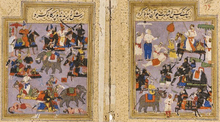Ahmadnagar Sultanate
| Ahmadnagar Sultanate Nizam Shahi dynasty | |||||||||
|---|---|---|---|---|---|---|---|---|---|
| 28 May 1490–1636 | |||||||||
 | |||||||||
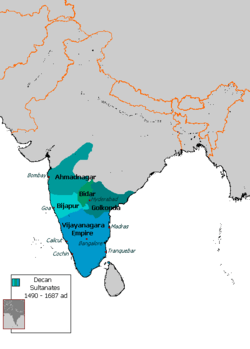 Extent of Ahmadnagar Sultanate | |||||||||
| Capital |
Ahmednagar Paranda Aurangabad. | ||||||||
| Common languages |
Persian (official)[1] Deccani Urdu Marathi | ||||||||
| Religion | Islam | ||||||||
| Government | Monarchy | ||||||||
| Nizam Shah | |||||||||
• 1490–1510 | Ahmad Nizam Shah I | ||||||||
• 1510-1553 | Burhan Nizam Shah I | ||||||||
• 1553-1565 | Hussain Nizam Shah I | ||||||||
• 1565-1588 | Murtaza Nizam Shah I/Chand Bibi | ||||||||
• 1588-1589 | Hussain Nizam Shah II | ||||||||
• 1588-1591 | Isma'il Nizam Shah | ||||||||
• 1591-1595 | Burhan Nizam Shah II | ||||||||
• 1595-1596 | Ibrahim Nizam Shah/Chand BBibi | ||||||||
• 1596-1596 | Ahmad Nizam Shah II | ||||||||
• 1596-1600 | Bahadur Nizam Shah | ||||||||
• 1600–1610 | Murtaza Nizam Shah II | ||||||||
| History | |||||||||
• Established | 28 May 1490 | ||||||||
• Disestablished | 1636 | ||||||||
| Currency | Falus[2] | ||||||||
| |||||||||
| Today part of |
| ||||||||
The Ahmadnagar Sultanate was a late medieval Indian kingdom, located in the northwestern Deccan, between the sultanates of Gujarat and Bijapur. Malik Ahmad, the Bahmani governor of Junnar after defeating the Bahmani army led by general Jahangir Khan on 28 May 1490 declared independence and established the Nizam Shahi dynasty rule over the sultanate of Ahmednagar.[3] Initially his capital was in the town of Junnar with its fort, later renamed Shivneri. In 1494, the foundation was laid for the new capital Ahmadnagar. In 1636 Aurangzeb, then Mugal viceroy of Deccan finally annexed the sultanate to the Mughal empire.
History
Malik Ahmad was the son of Nizam-ul-Mulk Malik Hasan Bahri, originally a Hindu Brahmin from Beejanuggar (or Bijanagar) originally named Timapa.[4]:189 After the death of his father, he assumed the appellation of his father and from this the dynasty found by him is known as the Nizam Shahi dynasty. He founded the new capital Ahmadnagar on the bank of the river Sina. After several attempts, he secured the great fortress of Daulatabad in 1499.
After the death of Malik Ahmad in 1510, his son Burhan, a boy of seven was, installed in his place. In the initial days of his reign, the control of the kingdom was in the hands of Mukammal Khan, an Ahmadnagar official and his son. Burhan Shah I died in Ahmadnagar in 1553. He left six sons, of whom Hussain succeeded him. After the death of Hussain Shah I in 1565, his minor son Murtaza ascended the throne. During his minority, his mother Khanzada Humayun Sultana better known in history as Chand Sultana or Chand Bibi ruled as a regent for several years. Murtaza Shah annexed Berar in 1572. On his death in 1588, his son Miran Hussain ascended the throne. But his reign could last only a little more than ten months as he was poisoned to death. Ismail, a cousin of Miran Hussain was raised to the throne, but the actual power was in the hands of Jamal Khan, the leader of the Deccani/Habshi group in the court. Jamal Khan was killed in the battle of Rohankhed in 1591 and soon Ismail Shah was also captured and confined by his father Burhan, who ascended the throne as Burhan Shah. But Chand Bibi fought him. Winning the kingdom, Chand Bibi ascended the throne. After the death of Chand Bibi in July, 1600 Ahmadnagar was conquered by the Mughals and Bahadur Shah was imprisoned.
Although, Ahmadnagar city and its adjoining areas were occupied by the Mughals, an extensive part of the kingdom still remained in possession of the influential officials of the Nizam Shahi dynasty. Malik Ambar and other Ahmadnagar officials defied the Mughals and declared Murtaza Shah II as sultan in 1600 at a new capital Paranda. Malik Ambar became prime minister and Vakil-us-Saltanat of Ahmadnagar.[5] Later, the capital was shifted first to Junnar and then to a new city Khadki (later Aurangabad). Malik Amber died in 1626. In the meantime, Jahan Khan, the wazir of Nizam killed Nizam on the reasoning that the Nizam was an incapable and unwise ruler, who couldn’t take appropriate decisions and was easily deceived by some people. Jahan Khan greeted Shahaji with open hands and asked Shahaji to join him. Shahaji started leading Nizam’s forces. However, at that time, the Mughal forces on the order of Shah Jahan had slain all the men in relation to Nizam and also killed two pregnant women. This was done to finish off the Nizamshahi, as there wouldn’t be any Male heir to the throne of the Nizam. However, Shahaji, in order to establish swarajy he decided to crown a child named Murtuza, who was in relation with Nizam as the next Nizam. Shahaji assured Murtuza’s mother that he would not be harmed and vouched for his safety.shahaji crowned murtuza on shahagad(pemgiri fort) at pemgiri (sangamner) in ahmednagar district Soon, Shah Jahan ordered the Subhedar of Deccan, Mahabat Khan to finish off the Nizamshahi when the commander-in-chief, Shahaji Bhosale was away. Mahabat Khan and Sardar Ranoji Wable attacked Ahmadnagar and quickly killed Fateh Khan along with the boy prince Hussain Nizamshah III, his relatives as well as two pregnant women so that there would not be any male heir to the throne. But soon, Shahaji with the assistance of Bijapur, placed an infant scion of the Nizam Shahi dynasty, Murtaza on the throne and he became the regent. The scion Nizam and Shahaji's family was stationed in the Mahuli Fort. Shah Jahan quickly made an alliance with Mohammed Adilshah of Bijapur and the respective Mughal and Adilshahi generals, Khan Zaman (son of Mahabat Khan ) and Ranadulla Khan (father of Rustum-e-Zaman) besieged Mahuli. Shah Jahan dispatched a force of 48,000 to reduce Shahaji, Nizam and his ally Adilshah. Under such mounting attack Adilshah sued for peace. With the withdrawal of Adilshah's support, Shahaji could not hold much against the Mughals. His possessions were reduced quickly. Portuguese did not offer any help from naval side to Shajaji due to fear of the Mughals. In this war, Shahaji fought till the last. But, unfortunately Murtaza, the infant Nizam, was kidnapped by Mughals and for the purpose of saving the life of Nizam, it became necessary for Shahaji to make compromise. This compromise finished Nizamshahi. Shahaji, on the condition of protecting the life of little Mourtaza Nizam at any condition, handed him over to Shahajahan. Nizam was taken away by Sardar Ranoji Wable (regional sardar of Shah Jahan)to Delhi. He was inducted into Adilshahi. As a precaution Shahajahan, ensured that Shahaji was posted in deep south so as not to pose any challenge to Mughals. He finally became one of the top generals in the Adilshah's army, accepting a Jagir in his court, being based in Bengaluru (present-day Bangalore in Karnataka). Shahaji tried to break the siege externally several times, but failed. So Jijabai along with young Shivaji successfully escaped from Mahuli in disguise. However, the mother of scion Nizam, Sajeeda was caught while fleeing along with the Nizam. Nizam was brought before Shah Jahan and Mohammed Adilshah. Shah Jahan proposed to murder the boy Nizam so as to finish the Nizamshahi once and for all. But Shahaji intervened and requested Shah Jahan to change his decision. But Adilshah was adamant. After some thinking, Shah Jahan ordered Nizam's release much to the surprise of Adilshah. However, he set a condition that Shahaji would be placed in deep south so that he could not pose any challenge to Mughals. The Nizam was taken away by Shah Jahan to Delhi and was made a Sardar.[6]
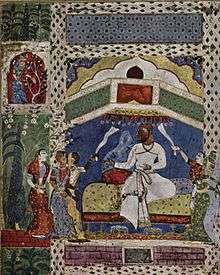
 Portrait of Burhan Nizam Shah II.
Portrait of Burhan Nizam Shah II.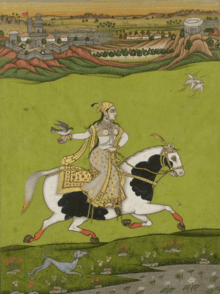 Chand Bibi, an 18th-century painting.
Chand Bibi, an 18th-century painting.
Army of the Nizam Shahi dynasty of Ahmadnagar Sultanate
Hussain Nizam Shah I is known to have been one of the leading figurehead of the Deccan Sultanates during the Battle of Talikota. After his death Chand Bibi repulsed an invasion by the Mughal Empire with the reinforcements of Bijapur Sultanate and Golconda Sultanate.
Revenue System of Malik Ambar
The revenue system introduced by Malik Ambar was based on the revenue system introduced in Northern India and some parts of Gujarat and Khandesh subahs by Raja Todarmal. Lands were classified as good or bad according to their fertility and he took a number of years to ascertain accurately the average yield of lands. He abolished the revenue farming. At first, revenue was fixed as two-fifths of the actual produce in kind, but later the cultivators were allowed to pay in cash equivalent to approximately one-third of the yield. Although an average rent was fixed for each plot of land but actual collections depended on the conditions of crops and they varied from year to year.[5]
List of rulers
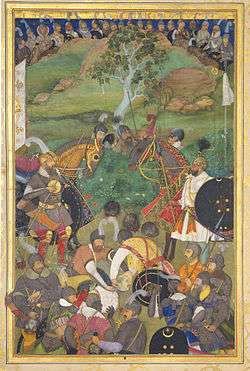
The following is the list of the Nizam Shahi rulers of Ahmadnagar:[8]
- Ahmad Nizam Shah I 1490–1510
- Burhan Nizam Shah I 1510–1553
- Hussain Nizam Shah I 1553–1565
- Murtaza Nizam Shah I 1565–1588
- Hussain Nizam Shah II 1588–1589
- Ismail Nizam Shah 1589–1591
- Burhan Nizam Shah II 1591–1595
- Ibrahim Nizam Shah 1595–1596
- Ahmad Nizam Shah II 1596
- Bahadur Nizam Shah 1596–1600
- Murtaza Nizam Shah II 1600–1610
- Burhan Nizam Shah III 1610–1631
- Hussain Nizam Shah III 1631–1633
- Murtaza Nizam Shah III 1633–1636
- Mughal historians and Emperors never referred to them as Nizam Shahs but rather as Nizam-ul-Mulk, since they were not recognized as equals.
Lineage
| 1. Ahmad Nizam Shah I Sultan of Ahmadnagar 1490-1509 | |||||||||||||||||||||||||||||||||||||||||||||||||||||||||||||||||||||||||||
| 2. Burhan Nizam Shah I Sultan of Ahmadnagar 1509-1553 | |||||||||||||||||||||||||||||||||||||||||||||||||||||||||||||||||||||||||||
| 3. Hussain Nizam Shah I Sultan of Ahmadnagar 1553-1565 | Muhammad Khudabanda | Shah Ali | |||||||||||||||||||||||||||||||||||||||||||||||||||||||||||||||||||||||||
| 4. Murtaza Nizam Shah I Sultan of Ahmadnagar 1565-1588 | 7. Burhan Nizam Shah II Sultan of Ahmadnagar 1591-1595 | Shah Tahir | 11. Murtaza Nizam Shah II Sultan of Ahmadnagar 1600-1610 | ||||||||||||||||||||||||||||||||||||||||||||||||||||||||||||||||||||||||
| 5. Hussain Nizam Shah II Sultan of Ahmadnagar 1588-1589 | 6. Isma'il Nizam Shah II Sultan of Ahmadnagar 1589-1591 | 8. Ibrahim Nizam Shah Sultan of Ahmadnagar 1595-1596 | 9. Ahmad Nizam Shah II Sultan of Ahmadnagar 1596 | 12. Burhan Nizam Shah III Sultan of Ahmadnagar 1610-1631 | |||||||||||||||||||||||||||||||||||||||||||||||||||||||||||||||||||||||
| 10. Bahadur Nizam Shah Sultan of Ahmadnagar 1596-1600 | 13. Hussain Nizam Shah III Sultan of Ahmadnagar 1631-1633 | 14. Murtaza Nizam Shah III Sultan of Ahmadnagar 1633-1636 | |||||||||||||||||||||||||||||||||||||||||||||||||||||||||||||||||||||||||
Art and architecture
 A pen and ink drawing of Ahmadnagar fort, c. 1885
A pen and ink drawing of Ahmadnagar fort, c. 1885_pg339_AHMEDNUGGUR_-_DUMREE_MUSJID.jpg) Ahmednagar fort (on the left side)
Ahmednagar fort (on the left side)
Under the reigns of successive rulers of the dynasty, architecture and art flourished in the kingdom. The earliest extant school of painting in the Deccan sultanates is from Ahmadnagar.[8] Several palaces, such as the Farah Bakhsh Bagh,[9] the Hasht Bihisht Bagh, Lakkad Mahal were built, as were tombs, mosques and other buildings.[10] Many forts of the Deccan, such as the fort of Junnar (later renamed Shivneri), Paranda, Ausa, Dharur, Lohagad, etc. were greatly improved under their reign. Daulatabad, which was their secondary capital, was also heavily fortified and constructed in their reign.[11] Literature was heavily patronised in the kingdom, as seen through manuscripts such as the Tarif-i Husain Shah Badshah-i Dakan.[12] Sanskrit scholarship was also given a boost under their rule, as desmonstrated by the works of Sabaji Pratap[13] and Bhanudatta.[14] The city of Ahmadnagar, founded by the Nizam Shahs, was described as being comparable to Cairo and Baghdad, within a few years of its construction.[15] It was modeled along the great cities of the Persianate world, given the Shi'i leanings of the dynasty.[16]
References
- ↑ Brian Spooner and William L. Hanaway, Literacy in the Persianate World: Writing and the Social Order, (University of Pennsylvania Press, 2012), 317.
- ↑ Stan Goron and J.P. Goenka, The coins of the Indian sultanates : covering the area of present-day India, Pakistan, and Bangladesh (New Delhi : Munshiram Manoharlal, 2001).
- ↑ Sen, Sailendra (2013). A Textbook of Medieval Indian History. Primus Books. p. 118. ISBN 978-9-38060-734-4.
- ↑ Ferishta, Mahomed Kasim (1829). History of the Rise of the Mahometan Power in India, till the year A.D. 1612 Volume III. Translated by Briggs, John. London: Longman, Rees, Orme, Brown and Green.
- 1 2 Majumdar, R. C., ed. (2007) [first published 1969], The Mughal Empire, History and Culture of Indian People, Bombay: Bharatiya Vidya Bhavan, pp. 415–45, ISBN 978-8172764074
- ↑ Shahaji Nizam
- ↑ Jayapalan, N. (2001). History of India. Atlantic Publishers & Distributors (P) Limited. p. 167. ISBN 9788171569281. Retrieved 2015-05-17.
- 1 2 Michell, George & Mark Zebrowski. Architecture and Art of the Deccan Sultanates (The New Cambridge History of India Vol. I:7), Cambridge University Press, Cambridge, 1999, ISBN 0-521-56321-6, p.274
- ↑ Pushkar Sohoni. "Change and Memory in Farah Bagh, Ahmadnagar" in Journal of Deccan Studies, v. 5 no. 2 (Jul–Dec 2007), pp. 59-77.
- ↑ Pushkar Sohoni. "Architecture of the Nizam Shahs" in Helen Philon (ed.), Silent Splendour: Palaces of the Deccan, 14th - 19th centuries (Mumbai: Marg Publications, 2010).
- ↑ Sohoni, Pushkar (2015). Aurangabad with Daulatabad, Khuldabad and Ahmadnagar. Mumbai; London: Jaico Publishing House; Deccan Heritage Foundation. ISBN 9788184957020.
- ↑ Aftabi (1987). Mate, M.S.; Kulkarni, G.T., eds. Tarif-i-Husain Shah, Badshah Dakhan. Pune: Bharat Itihas Samshodhan Mandal.
- ↑ Gode, P.K. (1944). "Sabaji Prataparaja, a protege of Burhan Nizam Shah of Ahmadnagar, and his works between 1500 and 1560". The Indian Historical Quarterly. 20: 96.
- ↑ Mishra, Bhanudatta (2009). Pollock, Sheldon, ed. "Bouquet of rasa" & "River of rasa". New York: New York University Press. ISBN 9780814767559.
- ↑ Astarabadi (Firishtah), Muḥammad Qāsim Hindū Shāh. Briggs, John, ed. History of the Rise of the Mahomedan Power in India, vol 3. London: Longman, Rees, Orme, Brown and Green. p. 201.
- ↑ Pushkar Sohoni. "Patterns of Faith: Mosque Typologies and Sectarian Affiliation in the Kingdom of Ahmadnagar" in David Roxburgh (ed.), Envisioning islamic art and architecture : essays in honor of Renata Holod (Leiden: Brill, 2014).
Further reading
- Shyam, Radhe (2008). Kingdom of Ahmadnagar, Delhi: Motilal Banarsidass, ISBN 81-208-2651-5
- Sohoni, Pushkar (2010). "Local Idioms and Global Designs: Architecture of the Nizam Shahs" (Doctoral dissertation, University of Pennsylvania).
- Sohoni, Pushkar(2015), Aurangabad with Daulatabad, Khuldabad and Ahmadnagar, Mumbai : Jaico Publishing House ; London : Deccan Heritage Foundation, ISBN 9788184957020
- Chopra, R.M. (2012), The Rise, Growth And Decline in Indo-Persian Literature, Iran Culture House, New Delhi, Chapter on "Persian Literature in Ahmadnagar Sultanate".
